----------------------------------------------------------------------------------------------
http://maps.google.com/?ll=32.63896,14.29047&spn=0.020996,0.029783&t=h&z=15
Ver mapa más grande
http://maps.google.com - LeptisMagna
----------------------------------------------------------------------------------------------
www.unesco.org/africa/portal/patrimoine/sites/183.htm
Archaeological Site of Leptis Magna
Inscribed :1982 Criteria: C (i) (ii) (iii)
Justification for Inscription:
Report of the 6th Session of the Committee
Brief description:
Leptis Magna was enlarged and embellished by Septimio Severo, who was born there and later became emperor. It was one of the most beautiful cities of the Roman Empire, with its imposing public monuments, man- made harbour, market place, storehouses, shops and residential districts.
Links with Partner Institutions: Leptis Magna, (Libya On Line)
Lepcis Magna Excavation Site
-------------------------------------------------------------------------------------
Mayo de 2012
-------------------------------------------------------------------------------------
Archaeological Site of Leptis Magna
| Libyan Arab Jamahiriya |
District of Khoms
32� 59' N, 14� 15' E |
Inscribed :1982 Criteria: C (i) (ii) (iii)
Justification for Inscription:
Report of the 6th Session of the Committee
Brief description:
Leptis Magna was enlarged and embellished by Septimio Severo, who was born there and later became emperor. It was one of the most beautiful cities of the Roman Empire, with its imposing public monuments, man- made harbour, market place, storehouses, shops and residential districts.
Links with Partner Institutions: Leptis Magna, (Libya On Line)
Lepcis Magna Excavation Site
-------------------------------------------------------------------------------------
Leptis Magna,
Libia ©UNESCO/Mady Dumas. Mayo de 2012. Comunicado de prensa, 23 de
mayo de 2012: La Directora General, preocupada por los ataques ...
www.unesco.org/new/es/...of.../emergency-actions-in-libya/
- Comunicado de prensa, 23 de mayo de 2012:
La Directora General, preocupada por los ataques al sitio del patrimonio mundial de Gadamés (Libia)
-------------------------------------------------------------------------------------
Leptis Magna
http://es.wikipedia.org/wiki/Leptis_Magna| Sitio arqueológico de Leptis Magna | |
|---|---|
Nombre descrito en la Lista del Patrimonio de la Humanidad. |
|
 Arco de Septimio Severo. |
|
| Coordenadas | Coordenadas: (mapa) |
| País | |
| Tipo | Cultural |
| Criterios | i, ii, iii |
| N.° identificación | 183 |
| Región | Países árabes |
| Año de inscripción | 1982 (VI sesión) |
 Plano de la ciudad excavada.
Plano de la ciudad excavada.
Leptis Magna, o Lepcis Magna, fue una ciudad importante de la república de Cartago, y posteriormente, del Imperio romano. Sus ruinas están ubicadas cerca de Trípoli en Libia. Han sido declaradas por la Unesco como Patrimonio de la Humanidad, en el año 1982.
Historia. Periodo romano
La ciudad fue fundada por colonos fenicios alrededor del 1100 a. C., aunque no alcanzó importancia hasta que Cartago se convirtiera en una potencia del Mar Mediterráneo en el siglo IX a. C. Siguió siendo parte de Cartago hasta el final de la Tercera Guerra Púnica en el 146 a. C., y se convirtió en parte de la República romana, aunque ya desde el 200 a. C. se consideraba como una ciudad independiente.La urbe contaba con un puerto y era el punto de partida de las caravanas que se dirigían al Fezzán. Gozó de éxito y crecimiento en esta época. Sus más antiguos monumentos latinos datan de la época de Augusto y Tiberio: estos fueron un teatro, la plaza principal del mercado y un arco monumental. Hacia el 16 d.C. una inscripción detalla que por orden del procónsul se estaba construyendo una calzada de la ciudad al interior de África.
Siguió perteneciendo a Roma hasta el reinado del emperador Tiberio, cuando Lepcis Magna y el área vecina se incorporaron formalmente al imperio como la provincia romana de África. En poco tiempo se convirtió en una de las ciudades líderes del África romana y en un centro comercial importante.
Lepcis fue una urbe cuyos habitantes no tenían la ciudadanía romana y era dirigida por dos sufetes (voz púnica para designar a un tipo de magistrados) y un concejo. Las inscripciones y edictos se hacían tanto en latín como en púnico. Los gobernantes de la urbe siguieron llevando nombres púnicos hasta hacia el 72 d.C. con Iddibal. El emperador Trajano, hacia el 109-110 le otorgó la categoría de colonia a la urbe y con ello concedía la ciudadanía a sus pobladores libres. En este tiempo era sufete el abuelo del futuro emperador Septimio Severo y quien luego adquiriría rango ecuestre.1
Lepcis Magna llegó a su apogeo a principios de 193 con el ascenso al trono imperial de Lucio Septimio Severo, quien era oriundo de la ciudad. Como emperador romano la tuvo como su favorita entre todas las ciudades provinciales, ya que con todas las construcciones y riquezas con que dotó a la ciudad, hizo de ella una de las más importantes ciudades de África, llegando a ser rival incluso de Cartago y Alejandría. Mandó a ampliar el puerto quedando impresionante, sin embargo, las modificaciones no rindieron fruto ya que poco después el puerto se llenó de arena. En el 205, el emperador y su familia visitaron la ciudad y fueron recibidos con grandes honores.
Durante la crisis del siglo III, cuando el comercio entró en declive, la importancia de Lepcis también sufrió y ya para mediados del siglo IV, gran parte de la ciudad había sido abandonada. Durante el reinado de Teodosio I gozó de un pequeño renacimiento.
Periodo postromano
En el 439, Lepcis Magna y las demás ciudades de Tripolitania cayeron bajo el dominio de los vándalos cuando su rey Genserico conquistó Cartago a los romanos y la hizo su ciudad. Por desgracia, el rey mandó a destruir las murallas de la ciudad para disuadir al pueblo de rebelarse contra el dominio vándalo. El resultado fue que en el año 523, un grupo de bereberes saqueó la ciudad causando daños a los vándalos y a la población.Belisario reconquistó Lepcis Magna en nombre del Imperio bizantino diez años más tarde y en el 534 destruyó el reino de los vándalos. Lepcis pasó a ser capital provincial del Imperio bizantino, pero nunca se recuperó de la destrucción causada por los bereberes. Ya para la conquista árabe de Tripolitania en los 650, la ciudad había sido abandonada salvo por una guarnición bizantina.
Hoy día, las ruinas de Lepcis Magna son de las más impresionantes del período romano.
Nuevos descubrimientos
En junio de 2005 se hizo público que los arqueólogos de la Universidad de Hamburgo que trabajaban en la costa de Libia, habían descubierto cinco mosaicos con un total de casi 30 pies de largo. Son originarios de los siglos I y II y muestran con claridad a un guerrero cazando un venado, a cuatro jóvenes peleando con un toro salvaje y a un gladiador descansando en estado de fatiga que mira a su oponente ya muerto. Los mosaicos decoraban las paredes de una piscina de agua fría en unas termas dentro de una casa romana en Wadi Lebda en Lepcis Magna. El mosaico del gladiador está considerado por los expertos como una de las muestras más finas de mosaicos representativos jamás vistos, comparable en calidad al mosaico de Alejandro Magno en Pompeya. Los mosaicos fueron descubiertos en el 2000, pero se mantuvo secreto el descubrimiento para evitar que fueran saqueados. [1]
Galería

Anfiteatro de Leptis Magna.
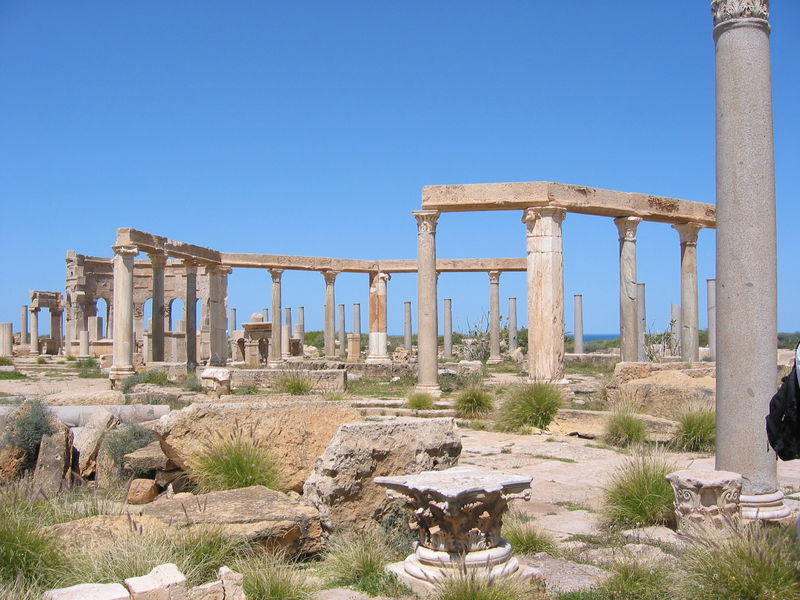
Mercado romano en Leptis Magna

Teatro romano en Leptis Magna.
Referencias
- ↑ Millar, Fergus (1992). El Imperio Romano y sus pueblos limítrofes. Siglo Veintiuno Editores. pp. 324.
Véase también
Enlaces externos
 Wikimedia Commons alberga
contenido multimedia sobre Leptis Magna.
Wikimedia Commons alberga
contenido multimedia sobre Leptis Magna.- Walda, Hafed; Kings College London; Sitio de un arqueólogo que trabaja en Lepcis Magna.
- Blázquez Matínez, José María (2001). «Leptis Magna. Patria de Septimio Severo». Revista de Arqueología 250 págs. 32-43.. Antigua: Historia y Arqueología de las civilizaciones.
- Vazquez Hoys, Ana (2008). «Leptis Magna, Tripolitania, Libia actual». Consultado el 17/02/2010.
- Reconstrucción de Leptis Magna
Videos
- José Luis Santos Fernández. (2009). Leptis Magna Libya (1/2). Valpard Films. Consultado el 17/02/2010.
- José Luis Santos Fernández. (2009). Leptis Magna Libya (2/2). Valpard Films. Consultado el 17/02/2010.
http://en.wikipedia.org/wiki/Leptis_Magna
| Archaeological Site of Leptis Magna | |
|---|---|
| Name as inscribed on the World Heritage List | |

The Arch of Septimius Severus
|
|
| Country | Libya |
| Type | Cultural |
| Criteria | i, ii, iii |
| Reference | 183 |
| UNESCO region | Arab States |
| Inscription history | |
| Inscription | 1982 (6th Session) |
History as a city
The city appears to have been founded by Phoenician colonists sometime around 1000 BC, who gave it the Lybico-Berber name Lpqy.[2][3] The town did not achieve prominence until Carthage became a major power in the Mediterranean Sea in the 4th century BC. It nominally remained part of Carthage's dominions until the end of the Third Punic War in 146 BC and then became part of the Roman Republic, although from about 111 BC onward, it was for all intents and purposes an independent city.
Severan Basilica
Leptis achieved its greatest prominence beginning in 193, when a native son, Lucius Septimius Severus, became emperor. He favored his hometown above all other provincial cities, and the buildings and wealth he lavished on it made Leptis Magna the third-most important city in Africa, rivaling Carthage and Alexandria. In 205, he and the imperial family visited the city and received great honors.
Among the changes that Severus introduced were to create a magnificent new forum and to rebuild the docks. The natural harbour had a tendency to silt up, but the Severan changes made this worse, and the eastern wharves are extremely well preserved, since they were hardly used.
Leptis over-extended itself at this period. During the Crisis of the Third Century, when trade declined precipitously, Leptis Magna's importance also fell into a decline, and by the middle of the fourth century, large parts of the city had been abandoned. Ammianus Marcellinus recounts that the crisis was worsened by a corrupt Roman governor named Romanus during a major tribal raid who demanded bribes to protect the city. The ruined city could not pay these and complained to the emperor Valentianian. Romanus then bribed people at court and arranged for the Leptan envoys to be punished "for bringing false accusations". It enjoyed a minor renaissance beginning in the reign of the emperor Theodosius I.
In 439, Leptis Magna and the rest of the cities of Tripolitania fell under the control of the Vandals when their king, Gaiseric, captured Carthage from the Romans and made it his capital. Unfortunately for the future of Leptis Magna, Gaiseric ordered the city's walls demolished so as to dissuade its people from rebelling against Vandal rule. The people of Leptis and the Vandals both paid a heavy price for this in 523 when a group of Berber raiders sacked the city.
Belisarius recaptured Leptis Magna in the name of Rome ten years later, and in 534, he destroyed the kingdom of the Vandals. Leptis became a provincial capital of the Eastern Roman Empire (see Byzantine Empire) but never recovered from the destruction wreaked upon it by the Berbers. It was the site of a massacre of Berber chiefs of the Leuathae tribal confederation by the Roman authorities in 543.[4] By the time of the Arab conquest of Tripolitania in the 650s, the city was abandoned except for a Byzantine garrison force.[citation needed]
History as a historical site
Today, the site of Leptis Magna is the site of some of the most impressive ruins of the Roman period.Part of an ancient temple was brought from Leptis Magna to the British Museum in 1816 and installed at the Fort Belvedere royal residence in England in 1826. It now lies in part of Windsor Great Park. The ruins are located between the south shore of Virginia Water and Blacknest Road close to the junction with the A30 London Road and Wentworth Drive.
2005 discoveries
In June 2005, it was revealed that archaeologists from the University of Hamburg had been working along the coast of Libya when they uncovered a 30 ft length of five colourful mosaics created during the 1st or 2nd century. The mosaics show with exceptional clarity depictions of a warrior in combat with a deer, four young men wrestling a wild bull to the ground, and a gladiator resting in a state of fatigue and staring at his slain opponent. The mosaics decorated the walls of a cold plunge pool in a bath house within a Roman villa at Wadi Lebda in Leptis Magna. The gladiator mosaic is noted by scholars as one of the finest examples of representational mosaic art ever seen—a "masterpiece comparable in quality with the Alexander Mosaic in Pompeii." The mosaics were originally discovered in the year 2000 but were kept secret in order to avoid looting. They are currently on display in the Leptis Magna Museum.[5]In the 2011 civil war
There were reports that Leptis Magna was used as a cover for tanks and military vehicles by pro-Gaddafi forces during the 2011 Libyan civil war.[6] When asked about the possibility of conducting an air-strike on the historic site, NATO refused to rule out the possibility of such an action saying that it had not been able to confirm the rebels' report that weapons were being hidden at the location.[7]Photo gallery
Much of Leptis Magna has yet to be excavated.
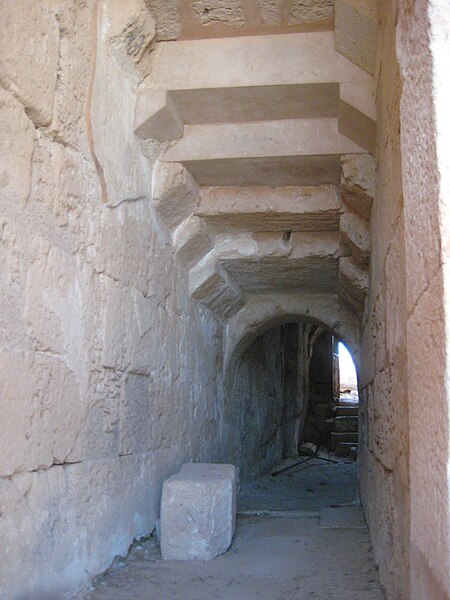
One of the entrances to theater (outside view)
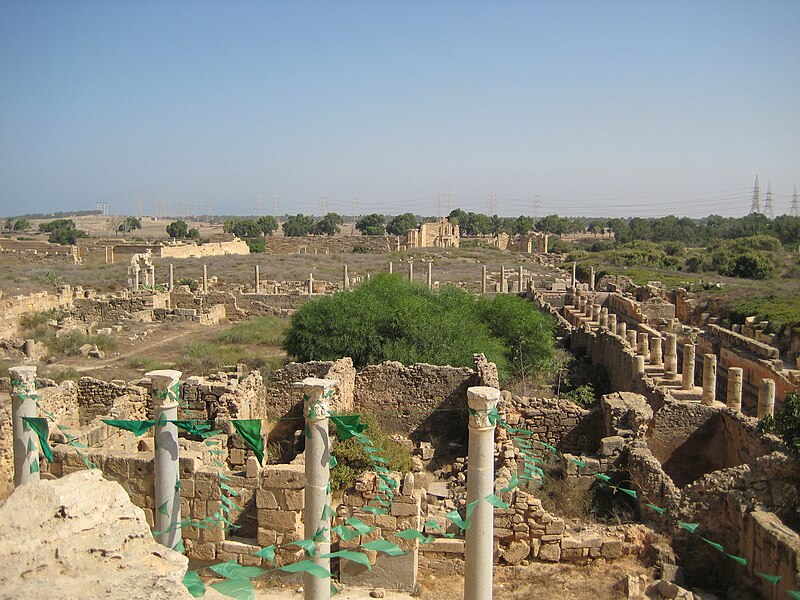
View on Leptis Magna from theater wall

Street view (from Septimius Severus arch to Trajan Arch)
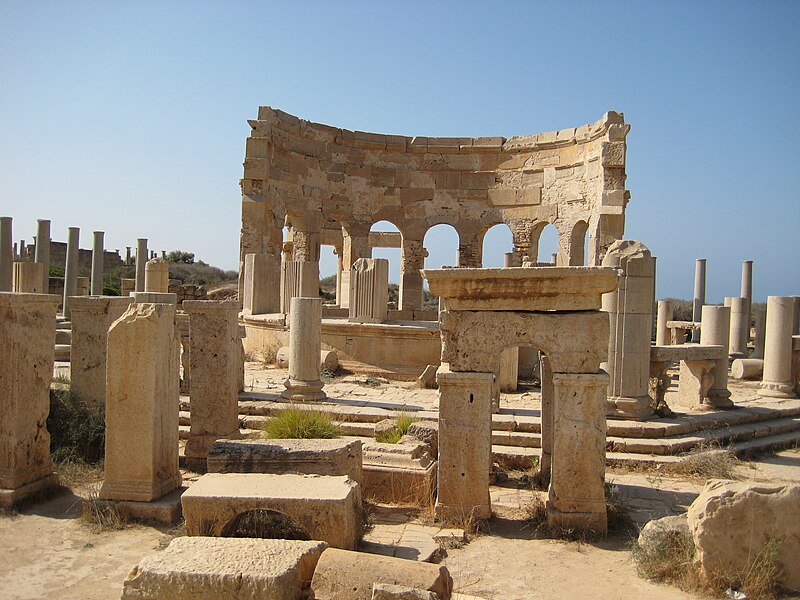
Market place
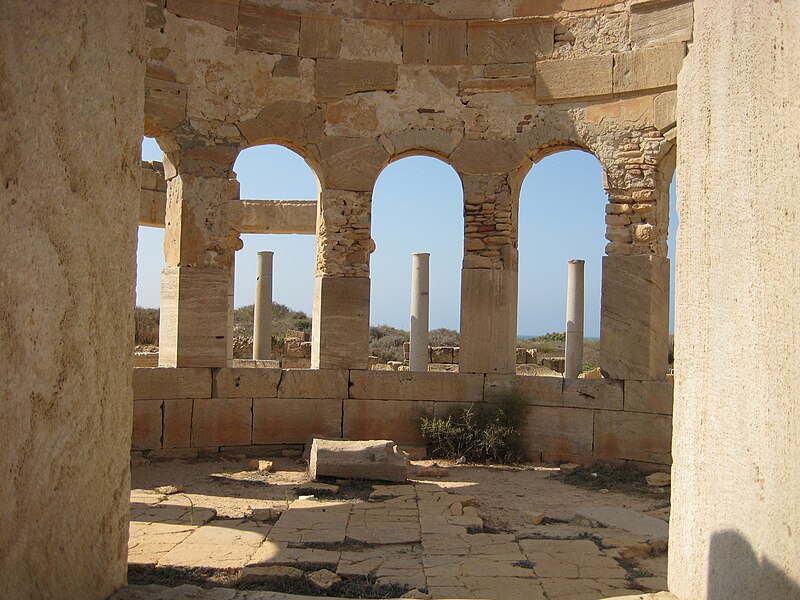
Market place
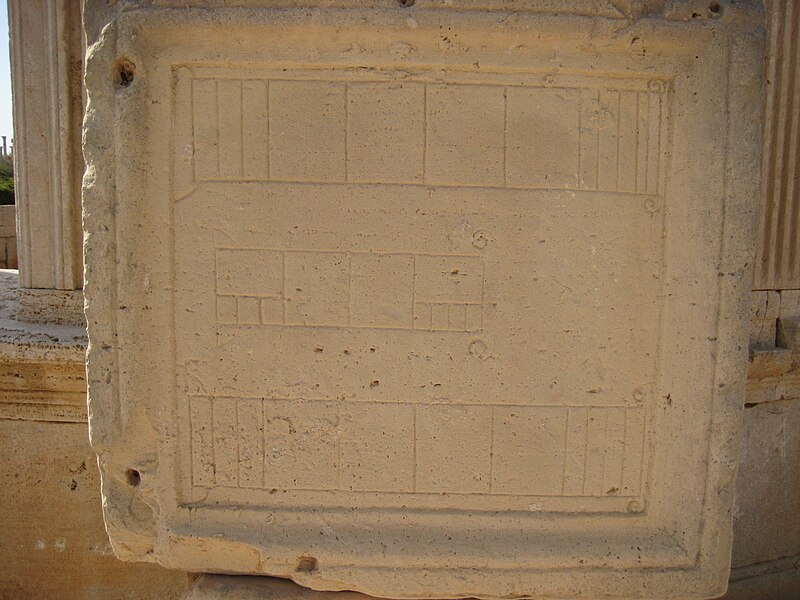
Measure converter, Market (founded 8–9 B.C.) (Phoenician colony)
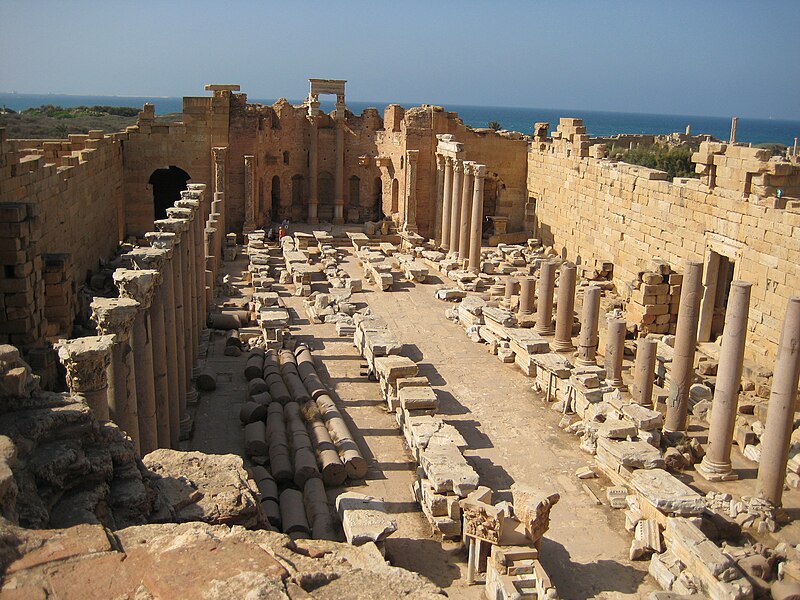
Severan Basilica, Leptis Magna 2nd century A.D.

Stairs inside Septimius Severus Basilica

Decoration columns inside Basilica of Septimius Severus
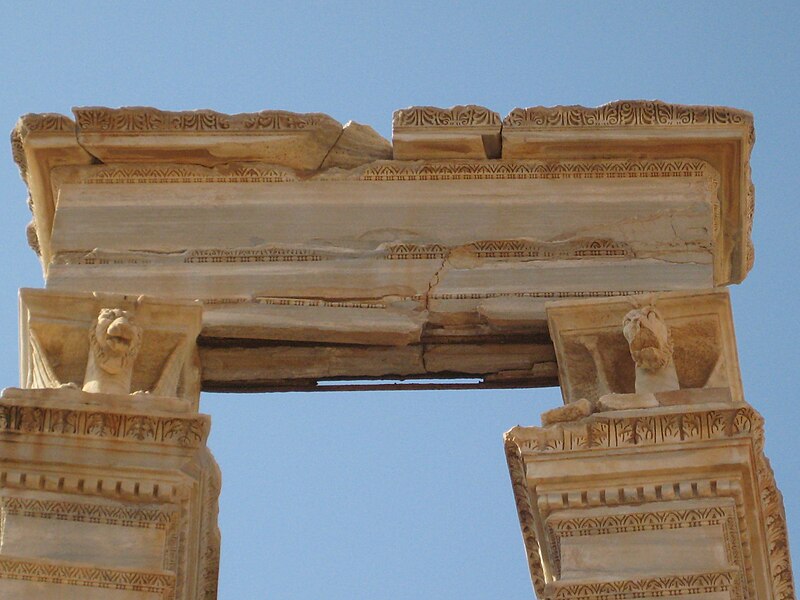
Severan Basilica

Forum in Leptis Magna, 2nd A.D.
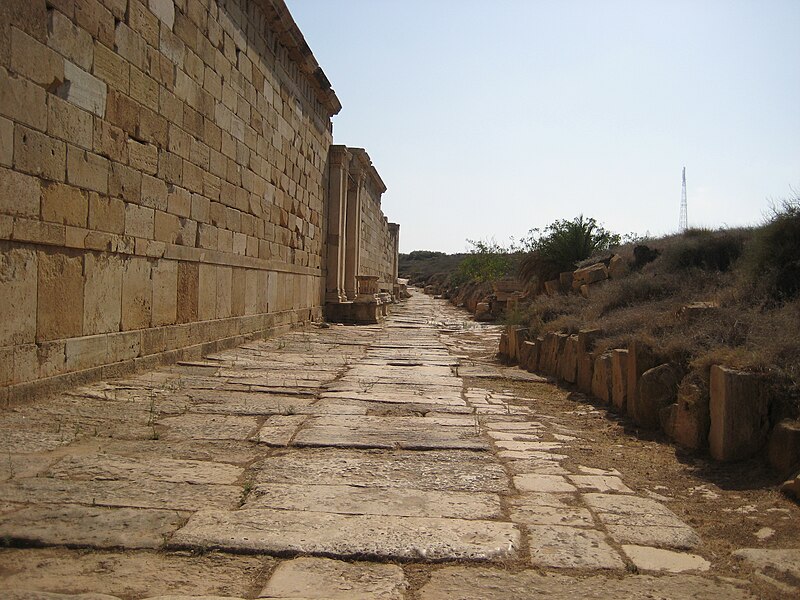
Wall of Leptis Magna forum, outside view

One of the Medusa heads, Severan forum

Latrines
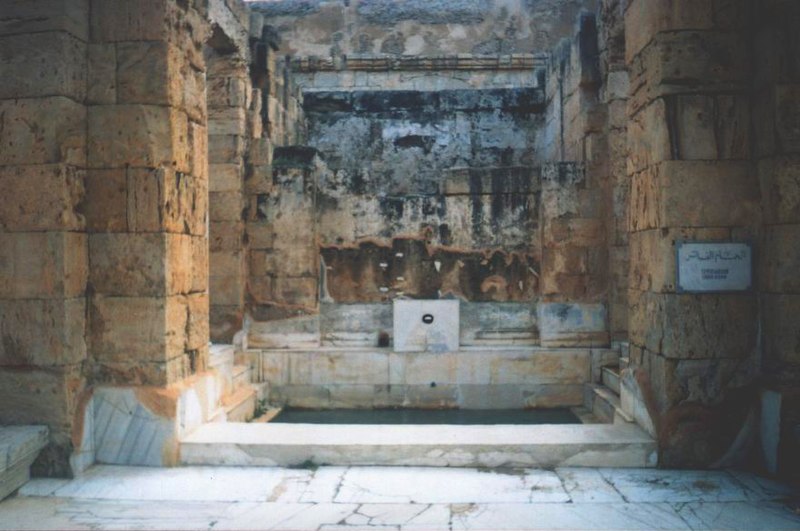
Tepidarium (in baths)
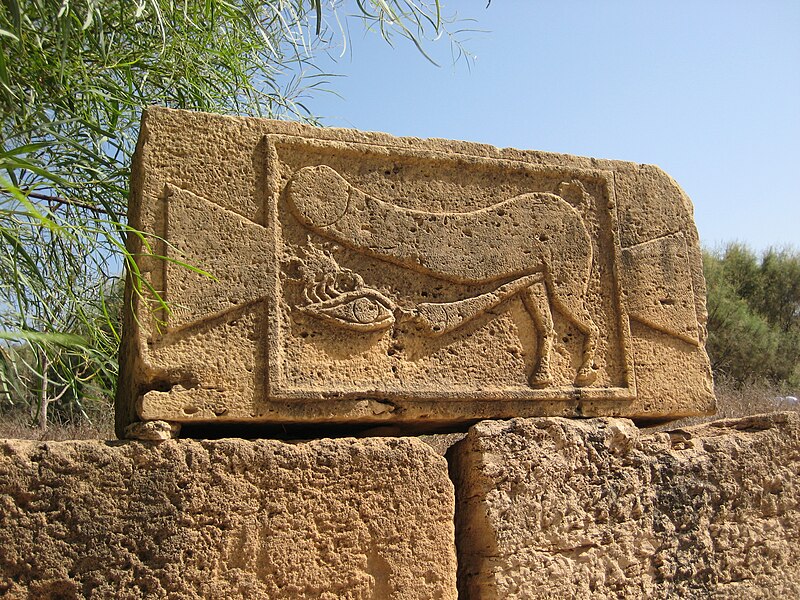
Bas-relief of fascinus or fascinum (amulet for protecting of "Evil eye"in Leptis Magna, 2nd century A.D. (Libya)
Bas-relief of fascinus
See also
References
- ^ "لَبْدَة Libya". Retrieved 2010-09-06..
- ^ "Archaeological Site of Leptis Magna". World Heritage List. UNESCO. Retrieved March 14, 2013.
- ^ Birley, Anthony Richard (1971) Septimius Severus Eyre and Spottiswoode, London, page 2, ISBN 0-413-26900-0
- ^
 "Leptis Magna". Catholic Encyclopedia.
New York: Robert Appleton Company. 1913.
"Leptis Magna". Catholic Encyclopedia.
New York: Robert Appleton Company. 1913. - ^ Alberge, Dalya, (June 13, 2005), "Roman Mosaic 'Worthy of Botticelli'", The Times Online, Accessed Sep 9 2006
- ^ "Misrata update and comments for June 7th and 8th". Libya 17th February. Retrieved 10 June 2011.
- ^ "CNN Wire Staff". Web Article. 14 June 2011. Retrieved 2011-06-14.
Additional references
- Richard Talbert, Barrington Atlas of the Greek and Roman World, (ISBN 0-691-03169-X), p. 35.
- Tomlinson, Richard A. (1992). From Mycenae to Constantinople: the evolution of the ancient city. New York: Routledge. ISBN 0-203-72114-4.
- Kreikenbom, Detlev, "Leptis Magna vor der arabischen Eroberung," in Detlev Kreikenbom, Franz-Christoph Muth, Joerg Thielmann (hg), Arabische Christen - Christen in Arabien (Frankfurt am Main u.a., Peter Lang, 2007) (Nordostafrikanisch / Westasiatische Studien, 6), 35–54.
External links
| Wikimedia Commons has media related to: Leptis Magna |
- Comprehensive website, by an archaeologist working on the site
- Livius.org: Lepcis Magna
- The Main Site at Leptis Magna - Satellite View on Google Maps
- The circus (top) and amphitheatre at Leptis Magna - Satellite View Google Maps
- Complete photo coverage of Leptis Magna
- Mattingly, D., R. Talbert, T. Elliott, S. Gillies. "Places: 344448 (Neapolis/Lepcis Magna)". Pleiades. Retrieved March 8, 2012 9:33 am.
- Official UNESCO page
- Photos, location map and info
UNESCO Leptis Magna Libya, ByzantineGate to the Theatre
UNESCO World Heritage sites in Libya اثار ليبيا
Archaeological Site of Leptis Magna (UNESCO/NHK)
Leptis Magna
http://www.youtube.com/watch?v=y1GMqWOZYXo
<iframe width="640" height="480" src="http://www.youtube.com/embed/y1GMqWOZYXo?rel=0" frameborder="0" allowfullscreen></iframe>
Subido el 06/07/2006 valpard·745 vídeos
Visit of Leptis Magna (Libya) Part
1/2
(Leptis Magna is one of the finest roman cities in the mediterranean)
Arches of Septimus Severus, Hadrianic Bath, Basilica, Old forum
Don't forget to see Leptis Magna 2/2 with the famous Antoninus Pius Theatre and Marcus Aurelius Amphitheatre (for 16000 people)
VALPARD FILMS http://valpardfilms.free.fr
(Leptis Magna is one of the finest roman cities in the mediterranean)
Arches of Septimus Severus, Hadrianic Bath, Basilica, Old forum
Don't forget to see Leptis Magna 2/2 with the famous Antoninus Pius Theatre and Marcus Aurelius Amphitheatre (for 16000 people)
VALPARD FILMS http://valpardfilms.free.fr
http://www.youtube.com/watch?v=6cOaEaTlb3o
<iframe width="640" height="480" src="http://www.youtube.com/embed/6cOaEaTlb3o?rel=0" frameborder="0" allowfullscreen></iframe>
Subido el 06/07/2006 valpard·745 vídeos
Visit of Leptis Magna (Libya) Part
2/2
(Leptis Magna is one of the finest roman cities in the mediterranean)
Market, Theatre, Arches (Tibere & Trajan), Circus, Hippodrome
VALPARD FILMS http://valpardfilms.free.fr
Leptis Magna RAI
<iframe width="640" height="360" src="http://www.youtube.com/embed/wVYAwohCBZs?rel=0" frameborder="0" allowfullscreen></iframe>
RAiscienze·1.478 vídeosAlberto Angela ci guida a Leptis Magna, in Libia, il "granaio dell'Impero Romano".
Le playlist scientifiche sono su http://www.rai.tv/dl/portale/html/pal...
Ancient Roman City of Leptis Magna, Libya
<iframe width="640" height="480" src="http://www.youtube.com/embed/GhL7hKGsYpE?rel=0" frameborder="0" allowfullscreen></iframe>
Subido el 24/10/2007
UNESCO Leptis Magna Libya, Severun Arch to the Basilica
LEPTIS MAGNA con msc Poesia 23/11/2008
Leptis Magna, pearl of Libya
<iframe width="640" height="480" src="http://www.youtube.com/embed/QjJtTExz0LA?rel=0" frameborder="0" allowfullscreen></iframe>
7:29 Subido el 04/04/2009 de Paolo Vacca 3.955 reproducciones
(Leptis Magna is one of the finest roman cities in the mediterranean)
Market, Theatre, Arches (Tibere & Trajan), Circus, Hippodrome
VALPARD FILMS http://valpardfilms.free.fr
Leptis Magna RAI
<iframe width="640" height="360" src="http://www.youtube.com/embed/wVYAwohCBZs?rel=0" frameborder="0" allowfullscreen></iframe>
RAiscienze·1.478 vídeosAlberto Angela ci guida a Leptis Magna, in Libia, il "granaio dell'Impero Romano".
Le playlist scientifiche sono su http://www.rai.tv/dl/portale/html/pal...
Ancient Roman City of Leptis Magna, Libya
<iframe width="640" height="480" src="http://www.youtube.com/embed/GhL7hKGsYpE?rel=0" frameborder="0" allowfullscreen></iframe>
Subido el 24/10/2007
I visited the ruins of the
ancient Roman city of Leptis Magna in Libya in November 2004.
This was one of the great cities of the Roman world.
UNESCO Leptis Magna Libya, Severun Arch to the Basilica
LEPTIS MAGNA con msc Poesia 23/11/2008
Leptis Magna, pearl of Libya
<iframe width="640" height="480" src="http://www.youtube.com/embed/QjJtTExz0LA?rel=0" frameborder="0" allowfullscreen></iframe>
7:29 Subido el 04/04/2009 de Paolo Vacca 3.955 reproducciones
Leptis Magna is an ancient city
along the Mediterranean Sea, located near the modern-day city of
Al Khums in Libya. The city began as a trading port for the
Phoenicians around 1000 BC and then became part of the Roman
province of Africa Proconsularis. Leptis was the most easterly of
the three cities that gave the North African region of
Tripolitania its name.
The archaeological site is an Unesco World heritage site since December 17, 1982.
-------------------------------------------------------------------
UNESCO Leptis Magna Libya, ByzantineGate to the Theatre
<iframe width="640" height="360" src="http://www.youtube.com/embed/LJNwvaAlk5Q?rel=0" frameborder="0" allowfullscreen></iframe>
Subido el 06/03/2011
The archaeological site is an Unesco World heritage site since December 17, 1982.
-------------------------------------------------------------------
UNESCO Leptis Magna Libya, ByzantineGate to the Theatre
<iframe width="640" height="360" src="http://www.youtube.com/embed/LJNwvaAlk5Q?rel=0" frameborder="0" allowfullscreen></iframe>
A tour of the UNESCO World
Heritage site of Leptis Magna in Libya, from the Byzantine Gate to
the Theatre, in November 2009. Leptis Magna is situated 3 kms east
of Al Khums Libya.
UNESCO Leptis Magna Amphitheatre & Circus
<iframe width="640" height="360" src="http://www.youtube.com/embed/VR4VUn7dwYk?rel=0" frameborder="0" allowfullscreen></iframe>
Subido el 02/03/2011
UNESCO Leptis Magna Venetian Harbour & Museum
<iframe width="640" height="360" src="http://www.youtube.com/embed/5xpQ9HXAfjQ?rel=0" frameborder="0" allowfullscreen></iframe>
Subido el 03/03/2011 UNESCO Leptis Magna Amphitheatre & Circus
<iframe width="640" height="360" src="http://www.youtube.com/embed/VR4VUn7dwYk?rel=0" frameborder="0" allowfullscreen></iframe>
Subido el 02/03/2011
A tour of the UNESCO World
Heritage Site of Leptis Magna Libya. The famous remains of the
Leptis Magna Amphitheatre & Circus lie about 3 Kms east of
Al Khums in Libya.
UNESCO Leptis Magna Venetian Harbour & Museum
<iframe width="640" height="360" src="http://www.youtube.com/embed/5xpQ9HXAfjQ?rel=0" frameborder="0" allowfullscreen></iframe>
A tour of the UNESCO World
Heritage site of Leptis Magna Libya, the Venetian Harbour &
Museum situated three miles east of Al Khums
UNESCO Leptis Magna Libya, Severun Arch to the Basilica
Subido el 06/03/2011
A tour of the UNESCO World
Heritage site of Leptis Magna Libya, from the Severun Arch to the
Basilica in November 2009. Leptis Magna is situated 3 kms east of
Al Khums Libya.
UNESCO Cyrene Libya Temple of Zeus
Subido el 28/02/2011
Pictures of Leptis Magna in Libya - صور لمدينة لبدة الأثرية بليبيا
<iframe width="640" height="360" src="http://www.youtube.com/embed/-dFzbIfKNL4?rel=0" frameborder="0" allowfullscreen></iframe>
http://www.youtube.com/watch?v=-dFzbIfKNL4
Libye:Leptis Magna La "Rome Africaine" en danger de mort
Subido el 14/07/2011
Avec les combats qui font rage en
Libye Leptis Magna Patrimoine Mondial de l'humanité est en
danger de mort ; en effet le site se trouve à
proximité des lignes de front entre les troupes du
gouvernement Libyen et celles des insurgés.
La Directrice générale de l'Organisation des Nations Unies pour l'éducation, la science et la culture (UNESCO), Irina Bokova, a réitéré mardi son appel aux parties impliquées dans le conflit armé en Libye
Tandis que l'aviation de l'OTAN prépare un raid contre Leptis Magna, qui abriterait, suivant les renseignements de l'Alliance, des entrepôts d'armes et des pièces de DCA de l'armée de Kadhafi. Il est vrai que ces renseignements proviennent des rebelles et pour le moment ne sont pas vérifiés.
Evguéni Satanovski, président de l'Institut du Proche-Orient estime, lui, que la Convention de La Haye n'arrêtera pas probablement l'aviation de l'OTAN.
Je vous livre un reportage que j'avais fait en 2001 sur Leptis Magna en Libye
#Philippe et Maione Buffon 2001
La Directrice générale de l'Organisation des Nations Unies pour l'éducation, la science et la culture (UNESCO), Irina Bokova, a réitéré mardi son appel aux parties impliquées dans le conflit armé en Libye
Tandis que l'aviation de l'OTAN prépare un raid contre Leptis Magna, qui abriterait, suivant les renseignements de l'Alliance, des entrepôts d'armes et des pièces de DCA de l'armée de Kadhafi. Il est vrai que ces renseignements proviennent des rebelles et pour le moment ne sont pas vérifiés.
Evguéni Satanovski, président de l'Institut du Proche-Orient estime, lui, que la Convention de La Haye n'arrêtera pas probablement l'aviation de l'OTAN.
Je vous livre un reportage que j'avais fait en 2001 sur Leptis Magna en Libye
#Philippe et Maione Buffon 2001
llllllllllllllllllllllllllllllllllllllllllllllllllllllllllllllllllllllllllllllllllllllllllllllllllllllllllllllllllllllllllllllllllllllllllllllllllllllllllllllllllllllllllllllllllllllllllllllll
Anexo:Patrimonio de la Humanidad en Libia


Bienes culturales y naturales
 |
Sitio arqueológico de Leptis Magna |
| Bien inscrito en 1982. | |
Embellecida y engrandecida por uno de sus hijos, el emperador romano Septimio Severo, la ciudad de Leptis Magna fue una de las más bellas del Imperio Romano, con sus grandes monumentos públicos, su puerto artificial, su mercado, sus almacenes, sus talleres y sus barrios de viviendas. (UNESCO/BPI) |
 |
Sitio arqueológico de Sabratha |
| Bien inscrito en 1982. | |
Factoría fenicia a la que confluían los productos del interior del continente africano, Sabratha formó parte del efímero reino númida de Masinisa, antes de ser romanizada y reconstruida en los siglos II y III de nuestra era. (UNESCO/BPI) |
 |
Sitio arqueológico de Cirene |
| Bien inscrito en 1982. | |
Colonia de los griegos de Thera, Cirene fue una de las principales ciudades del mundo helénico. Posteriormente romanizada, continuó siendo una gran ciudad hasta el terremoto sobrevenido el año 365. En sus ruinas, célebres desde el siglo XVIII, está escrito un milenio de historia. (UNESCO/BPI) |
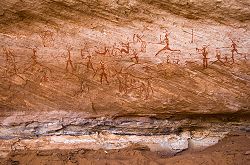 |
Sitio rupestre de Tadrart Acacus |
| Bien inscrito en 1985. | |
Colindante con el sitio argelino de Tasili n’Ajer, también inscrito en la Lista de Patrimonio Mundial, este macizo rocoso encierra miles de pinturas rupestres de diferentes estilos. Las primeras se remontan a 12.000 años antes de nuestra era y las más recientes datan del siglo I d.C. Esas pinturas muestran las considerables modificaciones experimentadas por la fauna y la flora a lo largo de ese periodo de más de 120 siglos, así como las distintas formas de vida de las poblaciones que se asentaron sucesivamente en esta región del Sahara. (UNESCO/BPI) |
 |
Ciudad vieja de Ghadames |
| Bien inscrito en 1986. | |
Construida en un oasis, Ghadames, “la perla del desierto”, es una de las más antiguas ciudades presaharianas y constituye un ejemplo notable de asentamiento humano tradicional. El reparto de funciones por planta es característico de su arquitectura doméstica: la planta baja sirve de almacén de provisiones; la planta superior cumple la función de vivienda familiar; y, por último, las terrazas a cielo abierto están reservadas a las mujeres. La planta superior domina una red de pasadizos cubiertos, sin luz, que permiten circular de forma prácticamente subterránea por toda la ciudad. (UNESCO/BPI) |
Lista indicativa
La inscripción en esta lista es la primera etapa para cualquier futura candidatura; sin embargo, Libia no ha presentado ninguna lista indicativa.Patrimonio cultural inmaterial
Actualmente Libia no tiene ningún elemento inscrito en la lista del Patrimonio Cultural Inmaterial.Enlaces externos
 Wikimedia Commons alberga contenido multimedia sobre Patrimonio de la Humanidad en Libia.
Wikimedia Commons alberga contenido multimedia sobre Patrimonio de la Humanidad en Libia. - UNESCO Patrimonio de la Humanidad en Libia (en inglés)
- UNESCO Patrimonio Cultural Inmaterial de la Humanidad (en español)
llllllllllllllllllllllllllllllllllllllllllllllllllllllllllllllllllllllllllllllllllllllllllllllllllllllllllllllllllllllllllllllllllllllllllllllllllllllllllllllllllllllllllllllllllllllllllllllll
http://www.recercaenaccio.cat/agaur_reac/AppJava/ca/projecte/070618-excavacio-arqueo/imatge/071220-reconstruccio-de.jsp
En aquesta imatge veiem la recreació de la ciutat romana de Leptis Magna, actual Líbia, que fou construïda sobre les restes d'una antiga ciutat de la República de Cartago.
lllllllllllllllllllllllllllllllllllllllllllllllllllllllllllllllllllllllllllllllllllllllllllllllllllllllllllllllllllllllllllllllllllllllllllllllllllllllllllllllllllllllllllllllllllllllllllllllllllllllllllllllllllllllllllllllllllllllllllllllllllllllllllllllllllllllllllllllllllllllllllllllllllllllllllllllllllllllll
Leptis Magna Museum http://en.wikipedia.org/wiki/Leptis_Magna_Museum
The Leptis Magna Museum is an archaeological museum that is located in Khoms, Libya.[1]
See also
References
- ^ "Leptis Magna Archaeological Museum". Temehu Tourism Services. Retrieved 28 November 2012.
| This article about a museum in Libya is a stub. You can help Wikipedia by expanding it. |
| This African archaeology article is a stub. You can help Wikipedia by expanding it. |
|
http://www.temehu.com/Cities_sites/museum-of-leptis-magna.htm maps http://www.temehu.com/libyamap/Khums.jpg 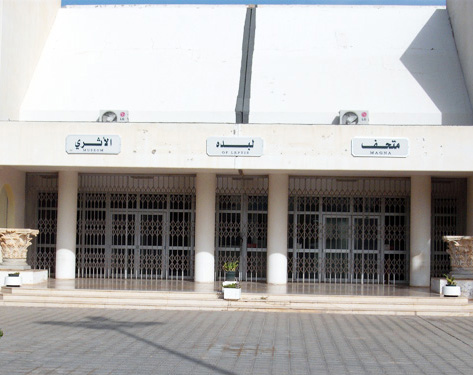 Leptis Magna Archaeological Museum
Archaeological Museum of Leptis Magna
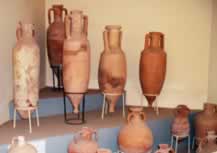 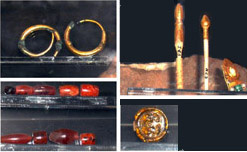 Leptis Magna is the home of Berber, Punic, Phoenician and Roman remains, as well as the home of the Berber Roman emperor Septimius Severus. Many of these archaeological finds are now housed in the museum, including statues and stelaes of Tannit, Bal, El, Zeus, Mars, Isis, Serapis, Apollo, Castor & Pollux and many more characters of classical mythology, busts, inscription-bearing rocks, pottery, jewellery, coffins and metal work. 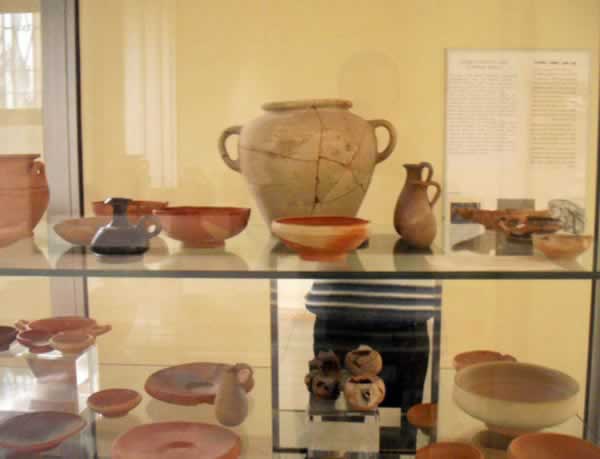
Roman pottery and tableware.
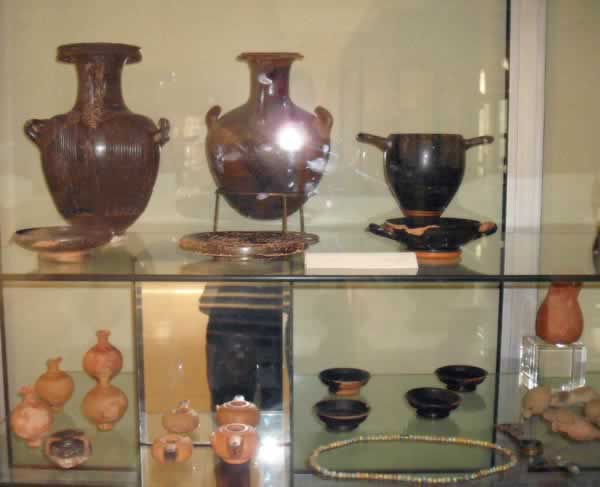 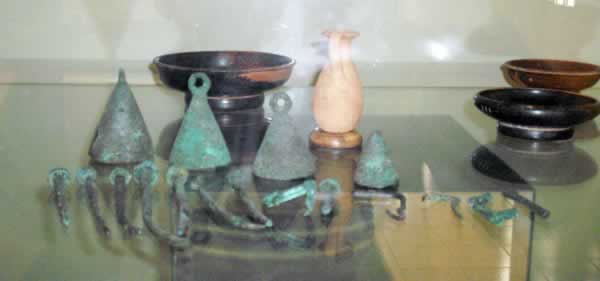 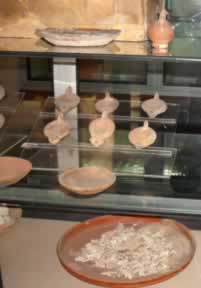 Clay Oil Lamps
Wadi Caam: The Greeks in Tripolitania!
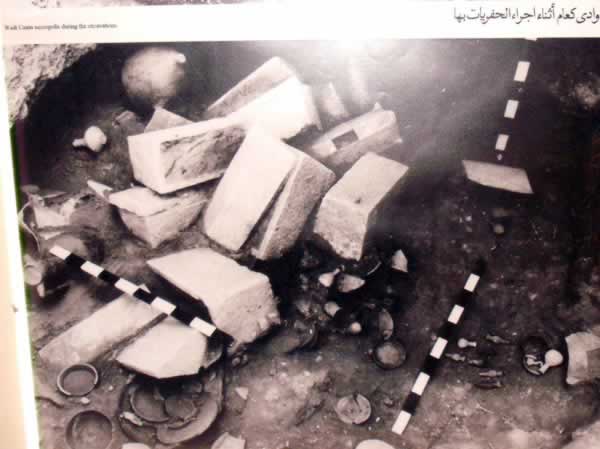
Wadi Ka'am (River Cinyps)
The Greek invasions of Crete and Rhodes of the 9th century BC
were shortly followed by their invasions of Egypt and Libya. Archaeology
and history provide ample evidence of their colonies in Cyrenaica, Eastern
Libya. But also there was a failed attempt to
colonise Tripolitania on the hands of Dorieus
the king of Sparta. Apparently, he reached
as far west as River Cinyps, also known as Wadi
Ka'am (Wadi Caam), just east of Leptis Magna,
where he founded a city by that name. However,
the Greeks were not welcomed by the local Carthaginians
(Berbers
&
Phoenicians) and subsequently were
driven out of the area after a short stay
of three years. The archaeological finds of Wadi
Caam have uncovered a Greek necropolis area dating
to the 3rd century BC, consisting of a series
of stone, box-shaped urns containing ashes and
bones, with the lids in the shape of a sloping
roof, as well as various classes of pottery and
tableware. 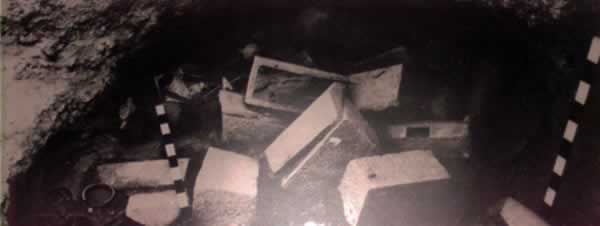
Note the square stone urns with the pyramidal
roofs, which appear to have been thrown in the hole in a hurry either to hide them or just dispose of them as
rubbish.
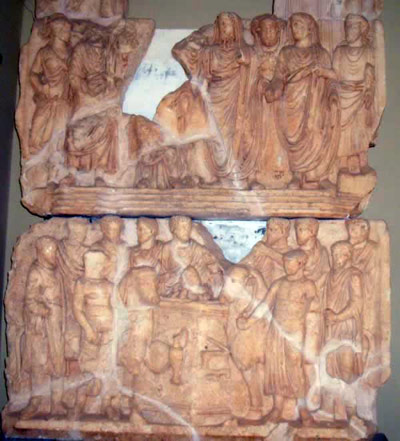
Marble relief showing sacrificial scenes in front of a temple.
The relief originally comes from the Arch of Septimius Severus. 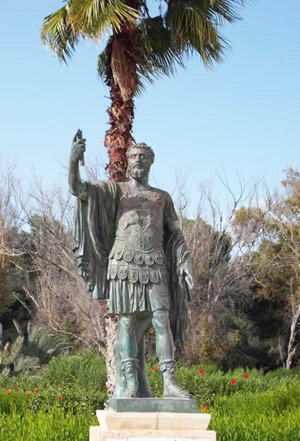 Septimius Severus was a Berber native of Leptis Magna, who went on to become the first African Roman Emperor. Under his command Leptis Magna witnessed an extraordinary burst of growth and development which earned the city its international status. His commanding personality and strong character are evident in the above sculpture. 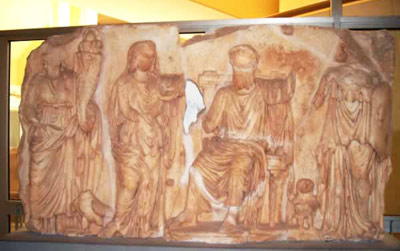
A marble relief from the
Arch of Septimius Severus
showing the Emperor and his wife as Jupiter
and Juno.
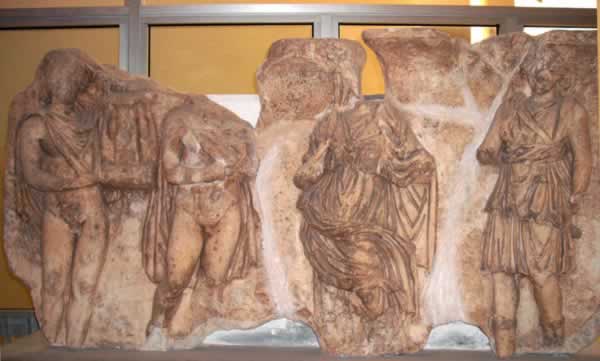
A marble relief from the Arch of Septimius Severus, showing Diana, Ceres,
Selvanu and Apollo.
MARS < > WARS
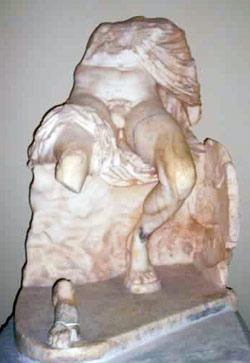
Seated headless marble statue of
the War-god Mars, 2nd AD.
The statue was found at the Frigidarium, in the passage to the hot rooms. 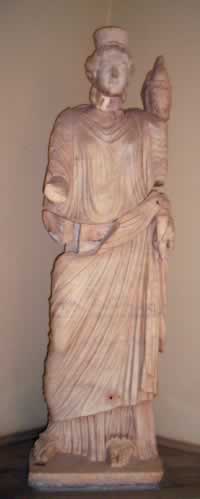
Libyan Goddess Isis 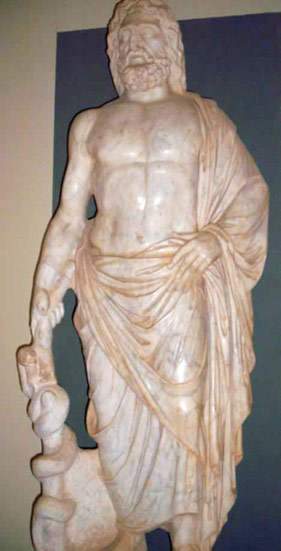
Asclepius the God of Medicine
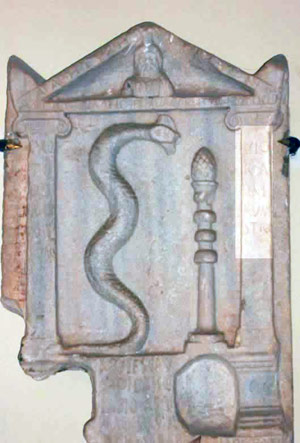 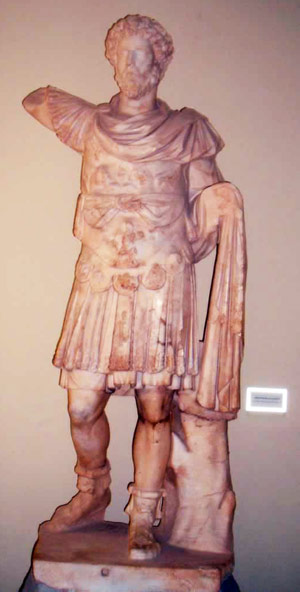
Statue of Marcus Aurelius
Mesratha Coin Treasure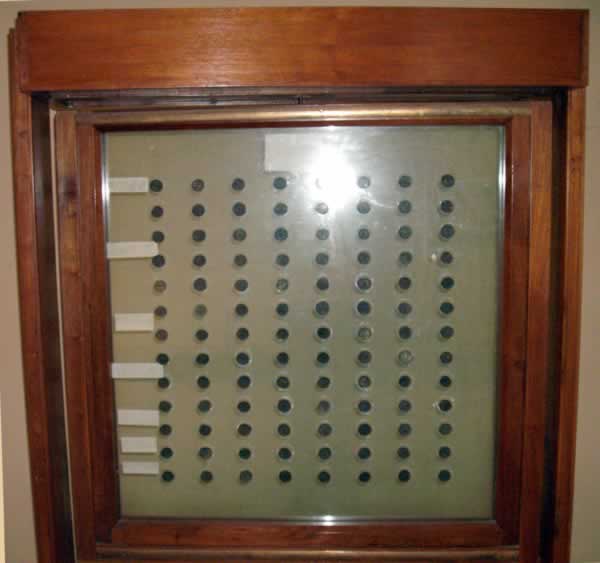 Mesratha Coin Treasure. It was said that the Mesratha treasure is the largest coin treasures in the world, containing at least 100,000 bronze coins, stored in clay jars. The treasure was found in February 1981, and was said to weigh six tonnes (6000 kilograms). The coins were said to date from the end of the third century (between 294 and 333 AD). 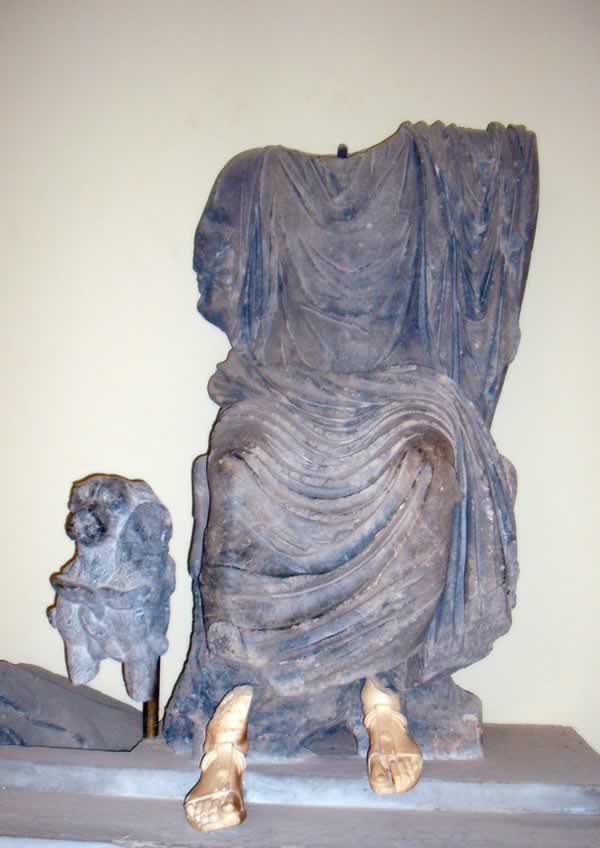
The God Serapis Seated on the Throne
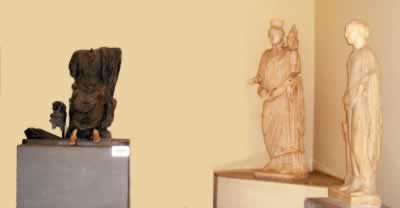
Isis & Serapis
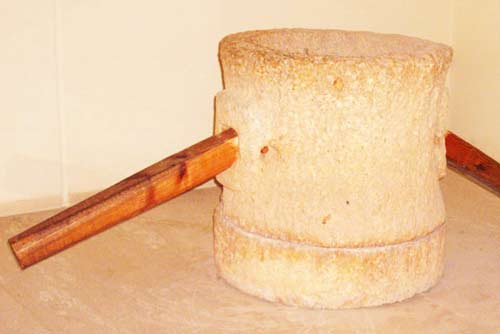 Large stone quern, with two wooden handles: heavy-duty mill for grinding large quantities of grain. Animals may have been used to turn the stone round. The top stone is unusually large, indicating that the mill may have been used to grind hard seeds and grains to produce finer flour. See Qasr Alhaj and the Museum of Lybia for other types of stone mills. 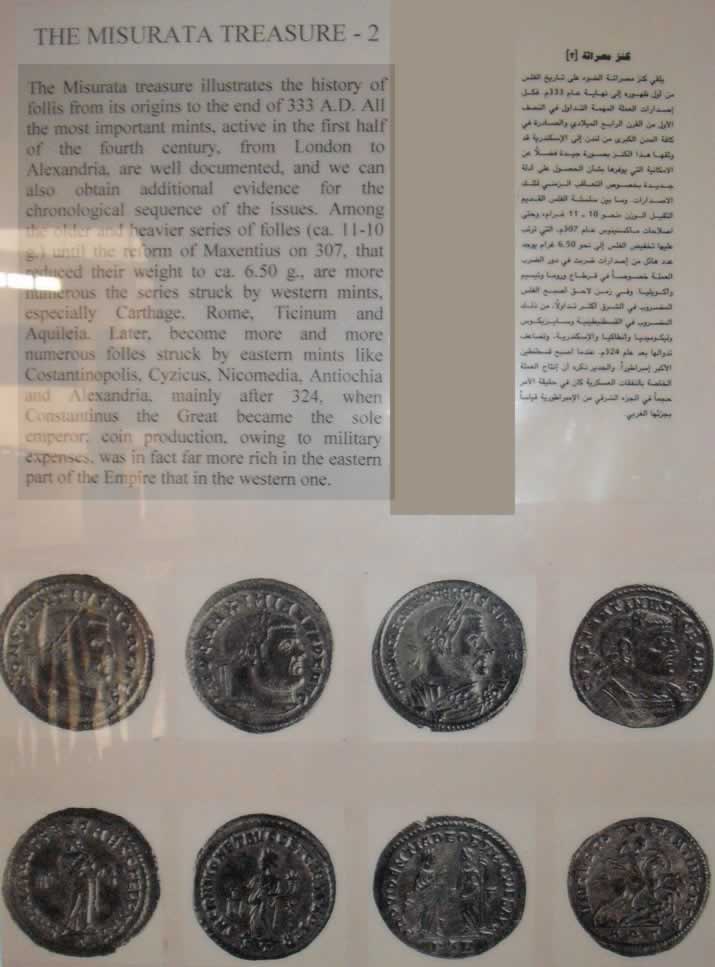 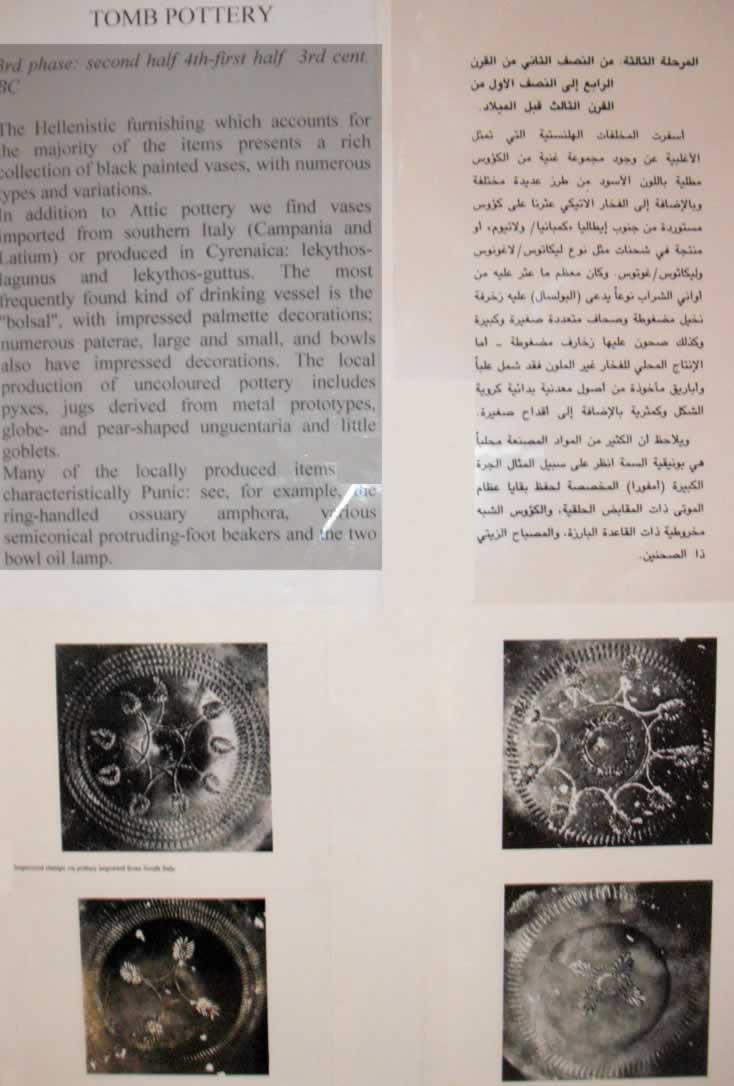 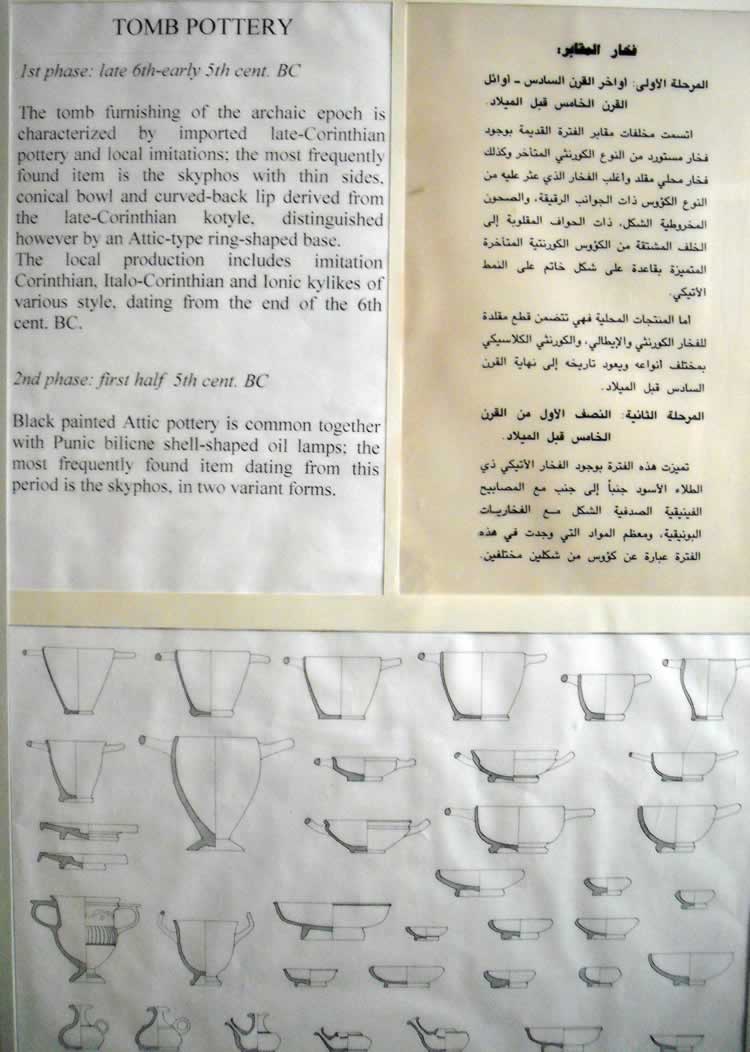 |
lllllllllllllllllllllllllllllllllllllllllllllllllllllllllllllllllllllllllllllllllllllllllllllllllllllllllllllllllllllllllll
http://www.bloganavazquez.com/2009/06/28/leptis-magna-tripolitania-libia-actua/
Escrito por Ana Vázquez Hoys.
Leptis Magna,Tripolitania,Libia actual

Septimio Severo( 146-211 d.C.)
Leptis Magna, o Lepcis Magna, fue una ciudad importante de la república de Cartago, y después del Imperio Romano. Sus ruinas están ubicadas cerca de Trípoli en Libia.
Han sido declaradas por la Unesco como Patrimonio de la Humanidad, en el año 1982.

Arco de Septimio Severo,Leptis Magna,Libia
an UNESCO World Heritage site, –located near the modern-day city of Al Khums in Libya.-
Siguió perteneciendo a Roma hasta el reinado del emperador Tiberio,
cuando Lepcis Magna y el área vecina se incorporaron formalmente al
imperio como la provincia romana de África. En poco tiempo se convirtió en una de las ciudades líderes de la África romana y en un centro comercial importante.
Reconstrucción de Leptis Magna, -www.recercaenaccio.cat/agaur_reac/AppJava/ca/..-
Lepcis Magna llegó a su apogeo a principios de 193 con el ascenso al trono imperial de Lucio Septimio Severo, quien era oriundo de la ciudad. Como emperador romano la tuvo como su favorita entre todas las ciudades provinciales, ya que con todas las construcciones y riquezas con que dotó a la ciudad, hizo de ella una de las más importantes ciudades de África, llegando a ser rival incluso de Cartago y Alejandría. En el 205, él y su familia visitaron la ciudad y fueron recibidos con grandes honores.
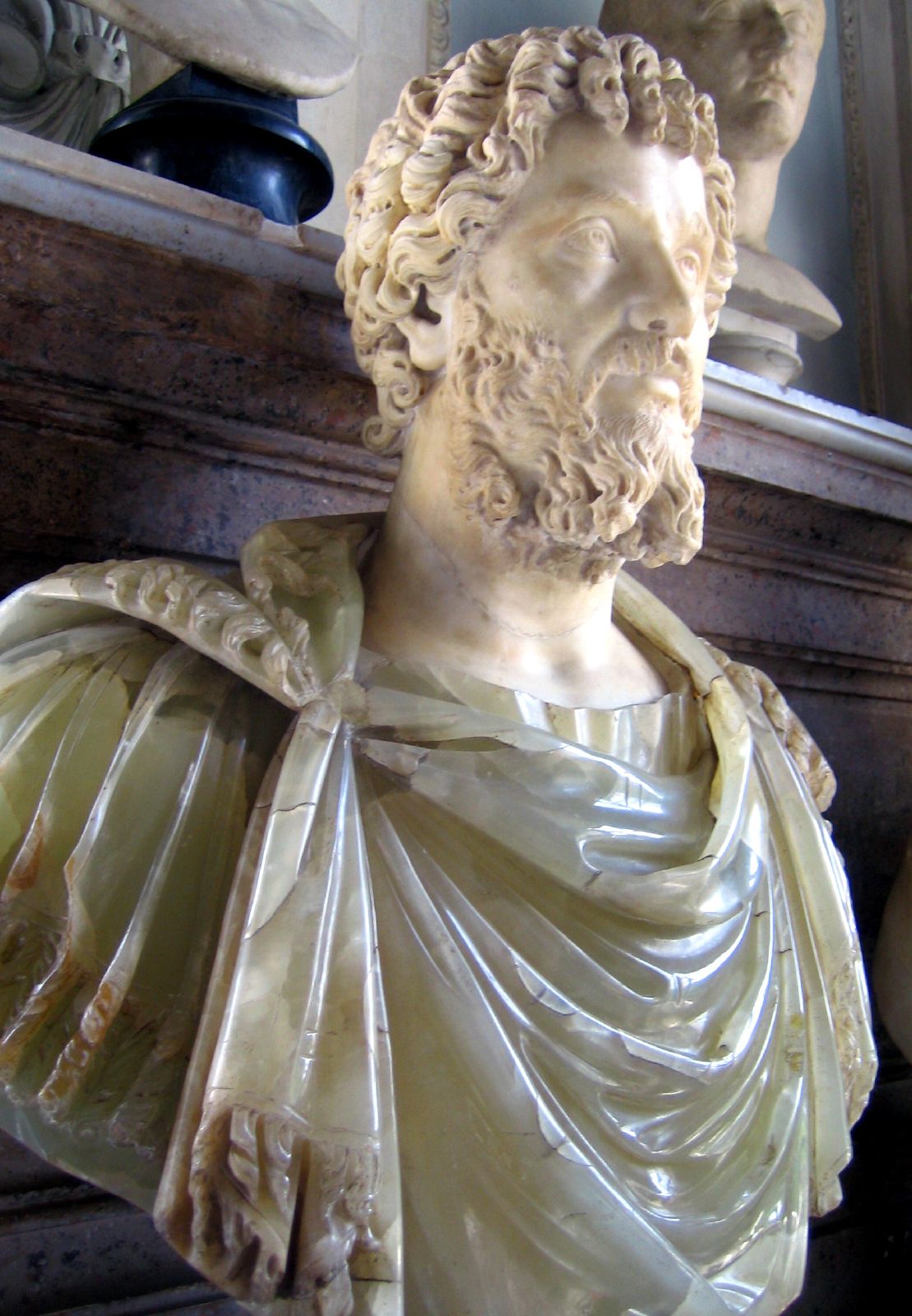
Septimio Severo
Durante la crisis del siglo III, cuando el comercio entró en declive, la importancia de Lepcis también sufrió y ya para mediados del siglo IV, gran parte de la ciudad había sido abandonada. Durante el reinado de Teodosio I gozó de un pequeño renacimiento.

http://www.libyana.org/maps/atlas/libda.jpg
En el 439, Lepcis Magna y las demás ciudades de Tripolitania
Tripolitania
Wikipedia,
Tripolitania o Tripolitana (árabe: طرابلس, transliterado: Tarābulus) es una región histórica de Libia occidental, centrada en la ciudad costera de Trípoli.La región fue originalmente habitada por la etnia bereber. En el siglo VII a. C. los fenicios instalaron colonias a lo largo de la costa que más tarde pasaría a estar bajo el control de Cartago. Los numidios la capturaron el 146 a. C. Los romanos llegaron un siglo más tarde, haciendo de Tripolitania una próspera región. Los vándalos asumieron el control de la región en 435 y en el siglo VI fueron suplantados por el Imperio Bizantino.
Italia la concedió oficialmente la autonomía después de la guerra, pero ocupó gradualmente la región. Administrada originalmente como una sola colonia, Tripolitania fue una única colonia desde el 26 de junio de 1927 hasta el 3 de diciembre de 1934 cuando pasó a formar parte de Libia.
Durante la Segunda Guerra Mundial fue ocupada por los aliados y hasta 1947 Tripolitania y Cirenaica fueron administrados por el Reino unido, Italia renunció formalmente ese mismo año a su demanda sobre el territorio].
…cayeron bajo el dominio de los vándalos cuando su rey Genserico conquistó Cartago de los romanos y la hizo su ciudad. Por desgracia, el rey mandó a destruir las murallas de la ciudad para disuadir al pueblo de rebelarse contra el dominio vándalo. El resultado fue que en el año 523, un grupo de bereberes saqueó la ciudad causando daños a los vándalos y la población.
Belisario reconquistó Lepcis Magna en nombre de Roma diez años más tarde y en el 534 destruyó el reino de los vándalos. Lepcis pasó a ser capital provincial del imperio bizantino, pero nunca se recuperó de la destrucción causada por los bereberes. Ya para la conquista árabe de Tripolitania en los 650, la ciudad había sido abandonada salvo por una guarnición bizantina.

Hoy día, las ruinas de Lepcis Magna son de las más impresionantes del período romano.
Libia en 1999
Lib

Leptis Magna
Carretera romana que lleva hacia el teatro.Leptis se benefició generosamente al negociar con roma oro en polvo, marfil, pieles y esclavos de colour traidos de África Ecuatorial por largas y difíciles rutas de caravanas a través de Fezzan.

Leptis Magna
El pequeño templo, en medio de los pasillos de columnatas detrás del teatro, lo construyó Iddibai Tapapius en el año 42 d.C. para los cultos a emperadores deificados tales como César y Augusto.
Leptis Magna
El Templo de Serapis con la Basílica Severan al fondo.
Leptis Magna
Al fondo, el Arco de Tiberio que se construyó en el año 35 d.C. en honor del hijo adoptado y sucesor de Augusto. Al frente, los restos de cuatro portales en forma de arco que se construyeron en el año 109 d.C. en gratitud al Emperador Trajan, por haber otorgado derechos cívicos romanos a los ciudadanos de Leptis.
Leptis Magna
Estos grandes baños públicos se construyeron alrededor de 120 d.C. y recibieron ese nombre por el emperador de ese tiempo, Hadrian. En esta fotografía, la gran piscina en el “frigidarium” (cuarto frío) del baño público.
Leptis Magna
El “tepidarium” (cuarto tibio), permitía una transición entre el “frigidarium” a la derecha y el “caldarium” (cuarto caliente) a la izquierda.
Leptis Magna
El suelo del “caldarium” se calentaba por el pasaje de gases calientes, a través de los espacios que se revelan en esta fotografía. Los romanos tenían radiación indirecta por el suelo antes que nosotros.
Leptis Magna
Las letrinas. Este es una pequeño ejemplo del tremendo paso retrógrada que dio la civilización con la caída de roma, cuyos ciudadanos conocían las virtudes de la higiene personal y de las letrinas públicas. Diez siglos más tarde, nadie se lavaba en Europa; los Reyes y sus Cortes hacían de todo por los pasillos y las escaleras de sus lindos palacios pues no tenían letrinas. En este tiempo, ¡el perfume no era un lujo, sino más bien una necesidad!
Leptis Magna
El Emperador Lucius Septimiu Severus, quien nació en Leptis en 146, favoreció su lugar de nacimiento con la construcción de magníficos edificios a finales del siglo II; entre ellos están una gran plaza (de la que solamente se aprecia una cuarta parte en esta fotografía), una enorme basílica y un acueducto subterráneo de 12 kms. Los arcos en la pared al fondo llevan hasta la Basílica Severan.Gorgona Medusa,Leptis Magna, -http://galen-frysinger.com/North%20Africa/leptis05.jpg–
(carved figures like this one (70) all around the Severn Forum)
detail from Severn basilica
http://www.galenfrysinger.com/leptis_magna_libya.htm
Leptis Magna
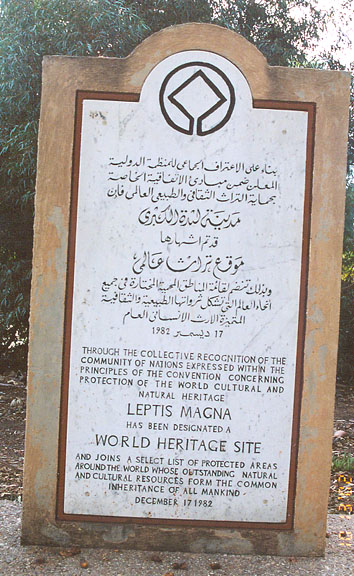
an UNESCO World Heritage site
Lepcis Magna or Leptis Magna, an
ancient city along the Mediterranean Sea, located near the modern-day city of Al
Khums in Libya. The city began as a trading port for the ancient people of
Phoenicia around 1000 BC and then became part of the Roman province of Africa
Proconsularis. Lepcis was the most easterly of the three cities that gave the
North African region of Tripolitania its name.
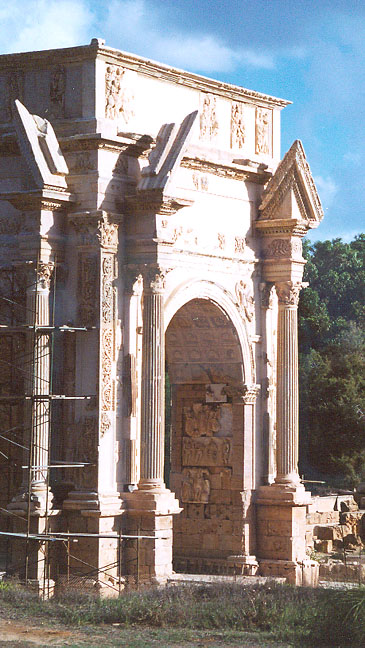
arch of Roman emperor Lucius Septimius Severus
(AD 146-211)
The city grew as a prosperous trading center, but
raids by desert tribes began in the 4th century AD and the city was virtually
abandoned by the 8th century.
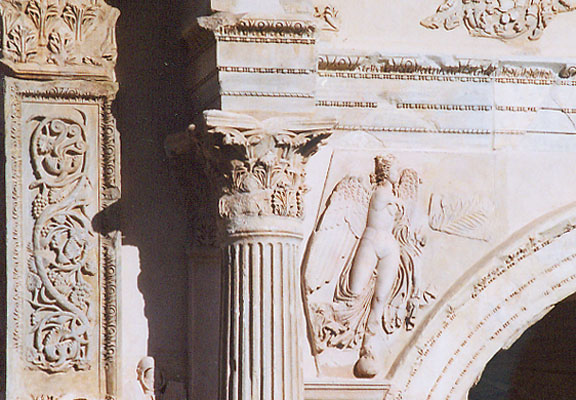
detail of the arch
Lepcis Magna was associated with the Roman Empire
for more than 600 years beginning in the 2nd century BC. During that time many
buildings were constructed using Roman architectural styles. These Roman structures, well preserved under sand for centuries,
have made the city an important area for archaeological study since the 1920s.
Lepcis Magna was also known as the birthplace of Roman emperor Lucius Septimius
Severus (AD 146-211).
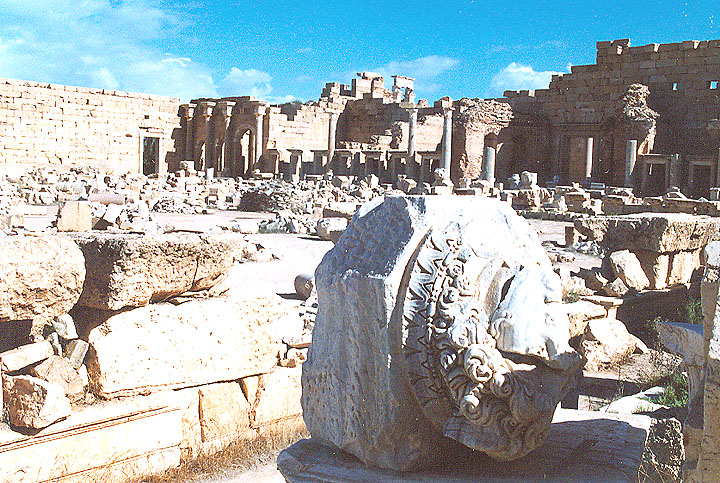
the Severn Forum
Lepcis Magna, which was located on a natural harbor protected by islands along
the North African coast, began as a Phoenician trading post. In the 6th century
BC Carthage became the dominant Phoenician colony and gradually took control of
other Phoenician areas in North Africa, including Lepcis Magna. In 202 BC the
Romans defeated Carthage in the Second Punic War. Emperor Trajan made Lepcis a
colonia, a Roman colony with full Roman citizenship rights for the city’s
population, in AD 109. The first Roman senator from Lepcis Magna began to serve
in the early 2nd century.
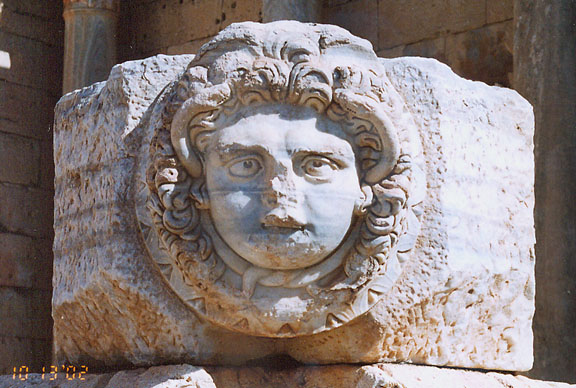
Gorgon head
(carved figures like this one (70) all around the Severn Forum)
(carved figures like this one (70) all around the Severn Forum)
Lepcis Magna enjoyed an unusual degree of autonomy under Roman rule. Unlike
other African cities, it lost no land and was not forced to accept Roman
settlers. It prospered because Rome stopped bandits from plundering the
countryside and curbed unrest among local tribal groups.
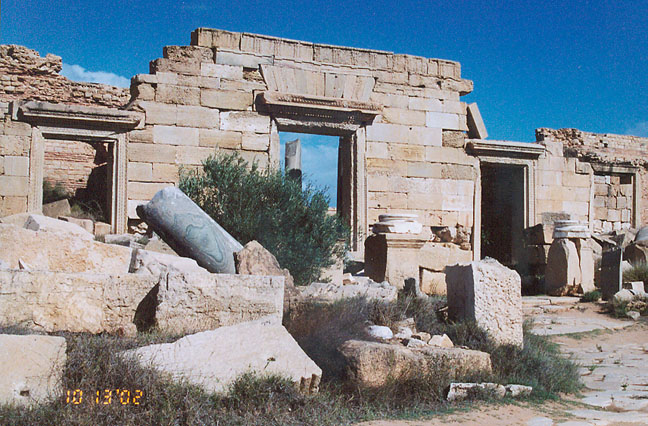
wall separating the Severn Forum from the Severn Basilica
During the Roman period, Lepcis was the Mediterranean outlet of a trade route
through the Sahara into the interior of Africa. Its economy was based on
agriculture, and some of its products, particularly olives, became profitable
trade items. Olive cultivation added so much to the town’s prosperity that in 46
BC the Roman ruler Julius Caesar imposed an annual tax of three million pounds
of oil on Lepcis. Inscriptions and literary sources attest to the wealth of the
Lepcis Magna elite, who supported the continuing growth of the city.
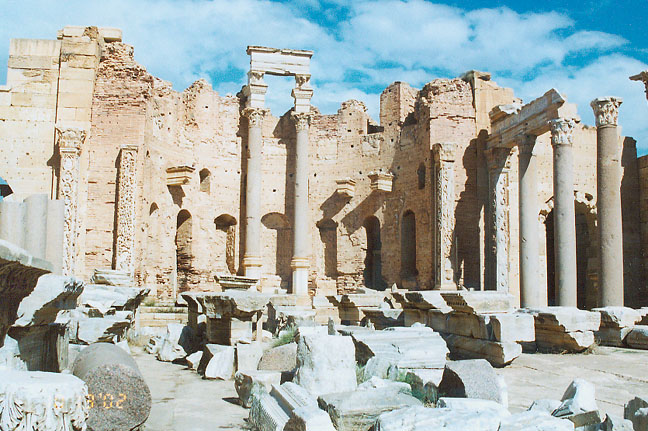
Apse of the Severn basilica
(Justinian converted it into a church in the 6th century AD)
(Justinian converted it into a church in the 6th century AD)
Late in the 1st century BC, a quarry was opened at Ras el-Hammam south of Lepcis
Magna that yielded an exceptionally fine, hard limestone used to build most of
the town’s later structures. In AD 120 the people of Lepcis Magna built an
aqueduct to carry water. In later years they also completed luxurious baths on
the model of the imperial baths in Rome, a large circus or racetrack, and other
public buildings.
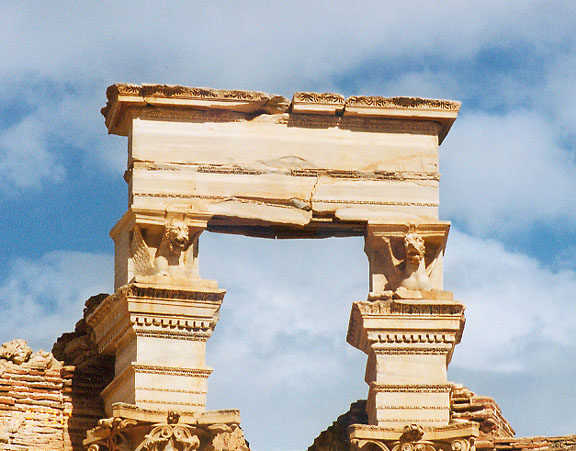
detail of the winged Griffins
A major period of construction occurred during the reign of Emperor Lucius
Septimius Severus, which began in 193. Septimius Severus was born in Lepcis
Magna. He honored his place of birth by funding an ambitious building program
that included a magnificent new forum and a richly decorated four-way arch
marking the intersection of the city’s two main streets. He also built a new
enclosed harbor linked to the city center by a broad street nearly 366 m (1201
ft) in length and lined with colonnades. Severus visited Lepcis Magna in 203 and
marked the occasion by announcing significant tax exemptions.
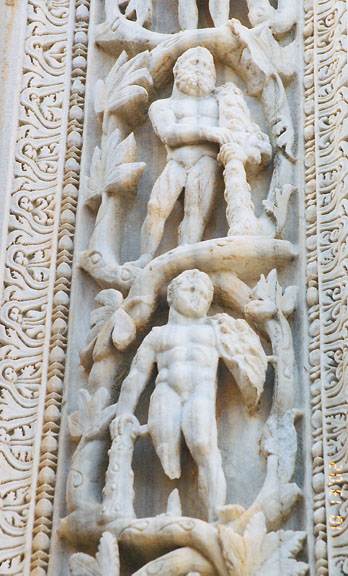
detail from Severn basilica
By the 4th century, the desert tribes of North Africa had grown strong, and they
raided the territory around Lepcis Magna. Initially, the city’s fortified walls
saved it from being plundered. Roman authority in North Africa had grown so
weak, however, that the Roman governor in the region would not help unless the
city provided camels and provisions for his army.
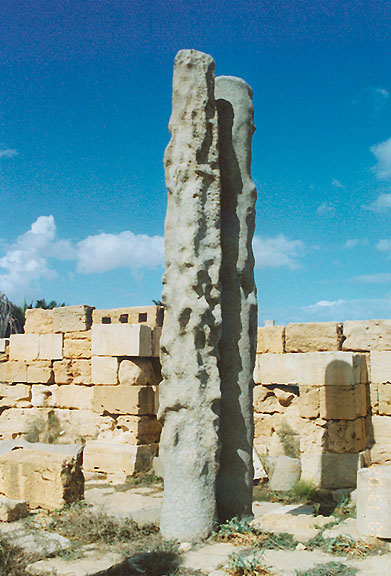
Civil Basilica, later converted to a Byzantine church
In 365 an earthquake damaged Lepcis Magna severely, but the greatest blow to the city’s prosperity came with
the invasion of a Germanic tribe called the Vandals about 455. By 534 Lepcis
Magna had become part of the Byzantine Empire. During this period of upheaval,
much of Lepcis Magna was abandoned. By the time Arabs controlled the region in
642, the city was almost empty.
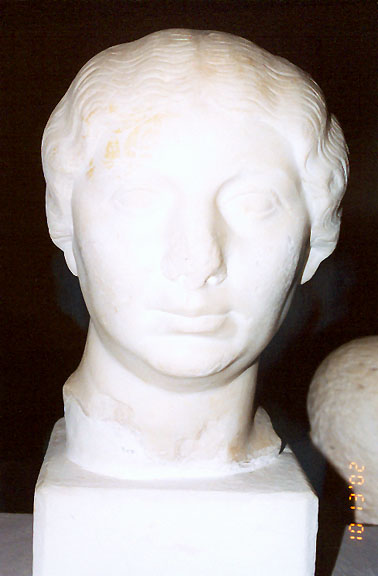
a Roman citizen
Because most of the Lepcis Magna’s fortified walls had been destroyed, the city was covered by sand over time. In the dry desert climate, the ruins of Lepcis Magna were preserved by these sand dunes. Between 1920 and World War II (1939-1945), when Libya was an Italian colony, Italian authorities began to excavate the city. After the war, the British continued work at the site and since that time have discovered many well-preserved Roman remains.
Panels from Leptis Magna
now in the National Museum, Tripoli
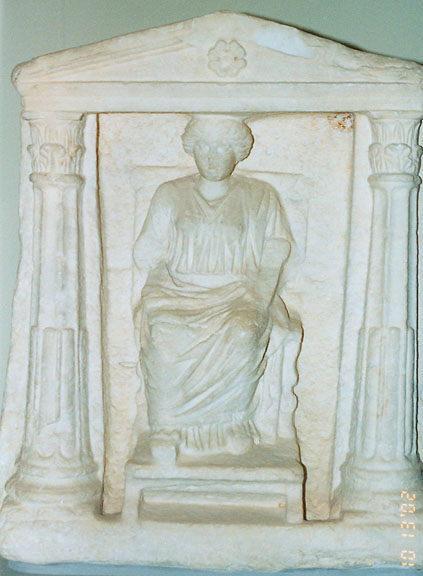

Archaeological excavations in Lepcis Magna have unearthed several layers of
ruins that show various periods of occupation at the site. Underneath the
remains of a large theater built in the 1st century AD is a cemetery probably
dating from the 4th or 3rd century BC. Particularly well-preserved are 2nd- and
early 3rd-century Roman buildings that include the elaborate Hadrianic Baths as
well the remains of the forum and basilica erected during the era of Emperor
Septimius Severus. The 3rd-century Hunting Baths, named for a fresco, are also
in remarkable condition. More recent discoveries have included a Roman house
with an extensive underground water system that provides new glimpses into the
everyday life of residents of Lepcis Magna.
Text by Microsoft Encarta
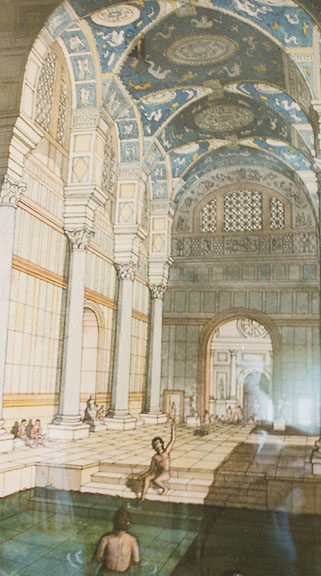
artist concept of the Hadrianic
baths
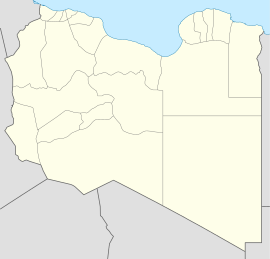




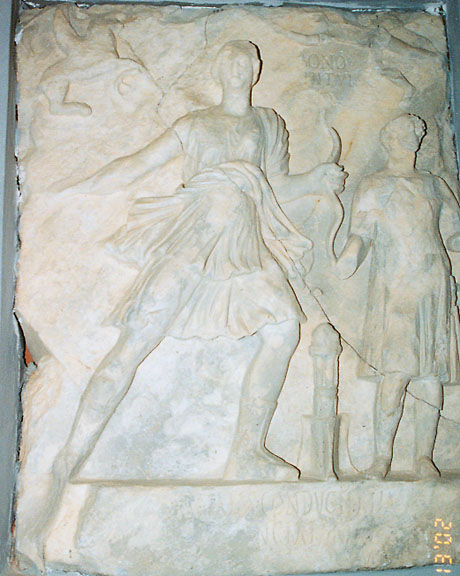
No hay comentarios:
Publicar un comentario